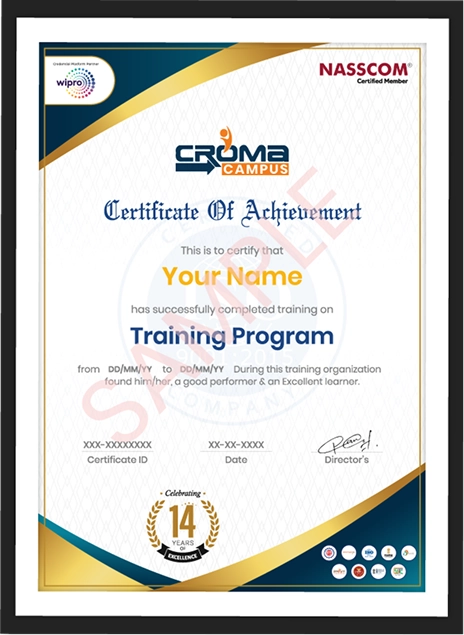Course Design By
Nasscom & Wipro
The course has been developed by industry experts to help you understand more about IoT networking protocols and to design powerful solutions.
With the IoT certification course in Delhi, you will be able to set up Raspberry Pi and get to learn programming sensors, actuators, and a lot more.
The IoT training in Delhi has been intended to teach all about IoT basics, IoT decision framework, etc.
Procure enough understanding of cloud or Azure IoT hub, and how to exhibit hub APIs in MS azure.
Also, get proficient in designing end-to-end solutions using various IoT technologies and tools as per the need with the help of the IoT training institute in Delhi.
Acquire substantial knowledge about performing data analytic techniques and get meaningful insights from the collected data by using prediction algorithms.
It is expected that by 2022, more than 50 billion devices will be connected by IoT.
By the end of 2022, the global market will reach from 700 billion to 2 trillion.
According to Glassdoor, an IoT certified developer can earn up to $150K in basic level and can earn even more with experience.
While IoT is in a nascent stage and still being used almost everywhere, it is estimated that the jobs in the IoT world will continue to increase as the industry expands.
Since there are more than 30 billion devices powered by IoT, there is a huge demand for trained and certified IoT experts as so as to manage workloads efficiently.
With the premium IoT training institute in Delhi, prepare yourself for global certification and cement your position in the IT sector.
Build an impressive resume along with 100% placement assistance and escalate in your career journey.
It reduces the risk of a thunderstorm by amplifying data analytic capabilities. It also saves millions of dollars as well.
It helps in achieving maximum customer satisfaction through logistics and operations management in enterprises.
According to research, there have been more than 50 billion devices interconnected in 2020 using IoT services.
You should have in-depth knowledge of IoT basic and advanced concepts.
You must have a functional idea about IoT basics, IoT architecture, IoT decision framework, and more.
You need to know to configure raspberry Pi, know about programming sensors, actuators, etc.
You must be able to end-to-end solutions using various IoT technologies and tools as per need.
You should have some idea about cloud or Azure IoT hub and should be able to demonstrate hub APIs in MS azure.
You must be proficient in IoT networking protocols and must be able to design powerful solutions as such.
You need to know all about performing data analytics techniques on to the collected data and should know how to use prediction algorithms to get meaningful insights from it.
we train you to get hired.

By registering here, I agree to Croma Campus Terms & Conditions and Privacy Policy
+ More Lessons
Course Design By

Nasscom & Wipro
Course Offered By

Croma Campus

Stories
success
inspiration


career upgrad


career upgrad


career upgrad


career upgrad
12-Jul-2025*
14-Jul-2025*
16-Jul-2025*
12-Jul-2025*
14-Jul-2025*
16-Jul-2025*

You will get certificate after
completion of program

You will get certificate after
completion of program

You will get certificate after
completion of program
in Collaboration with






Empowering Learning Through Real Experiences and Innovation

we train you to get hired.

Phone (For Voice Call):
+91-971 152 6942WhatsApp (For Call & Chat):
+91-971 152 6942Get a peek through the entire curriculum designed that ensures Placement Guidance
Course Design By


Course Offered By

Ready to streamline Your Process? Submit Your batch request today!
Here, at Croma Campus, you will get many advantages and get to understand topics like.
Unlike any other IoT Training Institute in Delhi, Croma Campus offers excellent online and live interactive trainer-led sessions. Thus, you will get to learn from professional trainers and clear your doubts.
Croma Campus provides learners with professional trainers having years of experience in the field of IoT. So, they can help you with real-life problems and share their experiences to help you understand the roles and responsibilities of IoT professionals.
Croma Campus offers a promising course structure and provides you with the best IoT Training in Delhi. Here, you will get live interactive online and offline modes of classes. The course structure focuses on lively discussions and finding practical solutions using real-life projects and assignments.
After completing the IoT training, Croma Campus will provide you with placement assistance and help you crack interviews. Moreover, they will help you with your resume to meet the latest industry standards.

FOR QUERIES, FEEDBACK OR ASSISTANCE
Best of support with us
For Voice Call
+91-971 152 6942For Whatsapp Call & Chat
+91-9711526942